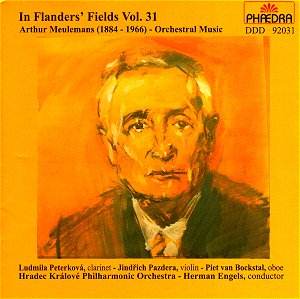Meulemans’ huge output includes many orchestral
works, a number of concertos as well as much chamber and vocal
music, the backbone of which undoubtedly consists of his fifteen
symphonies and of which shamefully little is available in recordings.
So, the present release offers a tantalising survey of his orchestral
music, albeit in small form and in lighter mood. These pieces
date from various periods in his long and prolific composing career.
Most of them are well-crafted and superbly scored works in which
Meulemans’ orchestral flair and mastery are clearly displayed.
The earliest piece here Twee Dansen
(Exotic Dance and Waltz) were originally written
for piano in 1911 and 1913 respectively, and orchestrated as a
diptych in 1930. These delightful miniatures are superior light
music, no doubt, but very attractive and entertaining in their
own right. The somewhat later Twee Movimenti for
violin and orchestra and Twee Idyllen for oboe and
orchestra both date from 1927, and are the kind of lighter stuff
that, say, Frank Bridge could have written, and none the worse
for that. The Second idyll ("of a city dweller") is
particularly fine; a sort of atmospheric urban idyll of great
charm.
Meulemans began thinking about his opera Adriaen
Brouwer in the early 1920s but completed the score only
in 1926. The first stage performance, planned for the 1940-1941
season of the Antwerp Opera, was cancelled partly because of the
outbreak of World War II and partly because the conductor thought
that it put too many demands upon the performers. It had to wait
until 1947 when Daniël Sternefeld conducted the first performance.
The overture, however, was written much later, in 1935. It is
an altogether more serious piece than the rest of this programme.
Meulemans conceived it as an orchestral fantasy or rhapsody on
themes from the opera. This is vintage Meulemans, and it gives
a fairly good idea of his mature works.
Adriaen Brouwer (1605–1638) was not the only
painter to inspire Meulemans. Actually, Rembrandt provided the
inspiration for the majestic Thirteenth Symphony (orchestra and
organ) of 1950, Bruegel for the orchestral suite Pieter
Bruegel of 1952 and David Teniers (1610–1690) for the
lovely Kermisfantasie op twee volksrythmen naar een schildreij
van David Teniers composed in 1930 in which Meulemans
pays a twofold tribute to Teniers and to Jan Blockx (1851–1912)
best known for his colourful Flemish Dances (available
on Naxos 8.550584). This is a delightful romp, vividly depicting
a peasant feast (Teniers excelled at such scenes) based on old
Flemish dance tunes dressed-up in gorgeous orchestral colours.
This is definitely the sort of thing that would be popular, were
it played more often.
The Rhapsody for clarinet and orchestra
(1932) is one of the many concertante works which Meulemans composed
throughout his long career. In turn, dramatic, declamatory or
lyrical, the music exploits the entire expressive palette of the
instrument. When it was published in the 1940s, the piece was
chosen as a test piece by several Belgian conservatories.
Meulemans composed many concertos. It is almost
a case of name an orchestral instrument and Meulemans has written
for it. There is one each for trumpet, trombone, timpani, saxophone
quartet and clarinet quartet besides those for the more usual
instruments: piano, violin, viola, cello, flute, horn and harp.
The Oboe Concerto dates from 1942 and is a perfect
example of Meulemans’ instrumental mastery. Not particularly demanding,
maybe, but quite rewarding to play and to listen to. Piet van
Bockstal obviously loves this engaging piece, as he did the earlier
Idyllen.
Everyone here plays with obvious enjoyment of
the music which must have been quite unfamiliar for the Czech
players who superbly rise to the occasion. Meulemans fans will
want to have this, and others too will find a lot to enjoy. Lighter
stuff, probably, but, it is to be hoped, a taste of "Things
to Come" as regards Meulemans’ still shamefully limited discography.
I now await for a long overdue recording of the masterly Ninth
Symphony, probably one of his finest, and – more generally – for
more of his music on discs.
Hubert Culot
